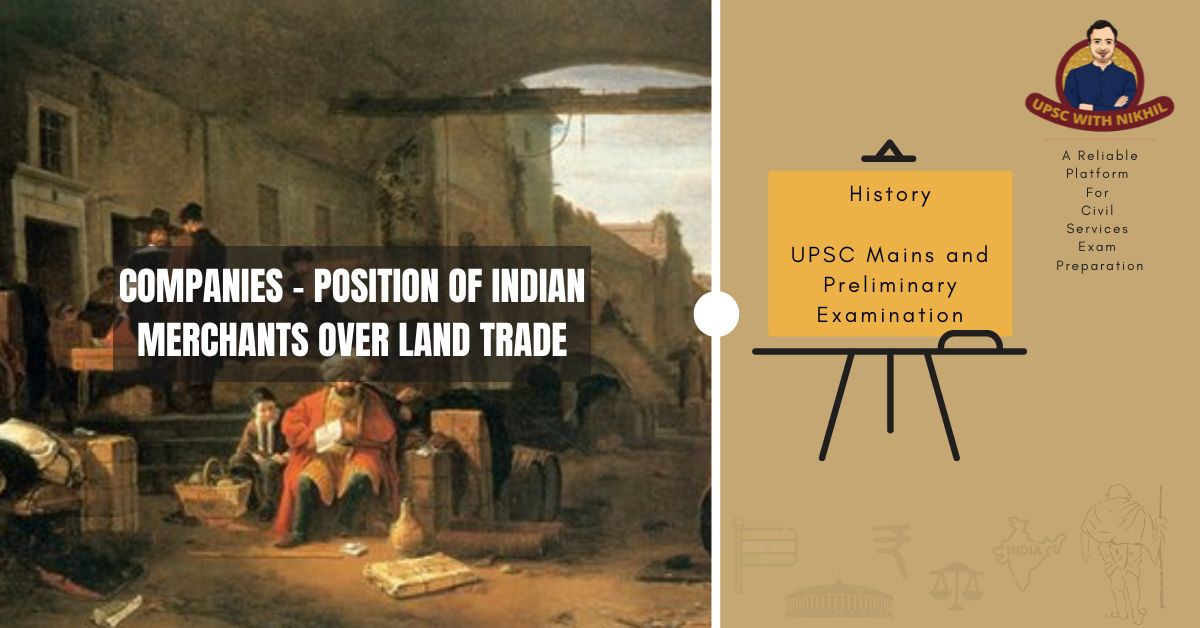Companies - Position Of Indian Merchants Over Land Trade - Medieval India
Introduction
Indian traders and Indian shipping had been primarily driven from the seas during the seventeenth and eighteenth centuries by the activities of the various European trading companies, and their dominance of the Indian Ocean. The "Continental aloofness" of the Indian state regarding the interest of the traders has now been largely disproved. According to a recent study, foreign companies' shares in several Indian regions, did not replace Indian traders in international trade, and Indian trade actually increased rather than decreased.
Position of Indian Merchants
• Ship owners and operators whose main business was long-distance and coastal trade served as the backbone of India's maritime trade.
• Indian traders continued to be involved in South-East Asian and West Asian trade after the Portuguese failed in their attempt to dominate the spice trade and drive out Indians, Arabs, Javanese, and other Asian traders.
• After the Portuguese failed to seize Aden at the mouth of the Red Sea, the Arabs took control of the Red Sea, Goa, and Cambay ports, with which Malabar conducted trade.
• With the establishment of the Dutch factory in Surat, the new Imperial port of Gujarat, and the expansion of their textile and indigo trade, they quickly realized that any attempt to keep Gujarati traders out of South-East Asia was by making them pay ten to twenty percent duty on their goods.
• The expansion of India's trade with ports in West Asia, however, was the major development of the time and it improved the position of Indian merchants.
Types of Indian Merchants
• There are various types of Indian merchants who operated for inland and overseas trade.
• At one extreme were wealthy magnates with a fleet of ships stationed in a single large entrepot port, such as Surat or Masulipatam, or a collection of ports, as those in central and southern Colombia, Bengal, and Orissa.
• Ship captains, or Nakhudas, would not stray even slightly from the trading and sailing instructions they were given while leaving Surat.
• There were other ship owners, each with five to 10 ships. Additionally, there were ships with a single owner that frequently traveled abroad.
• Muslim shipowners made up a large portion of the industry, but Hindus were by no means excluded.
• The second group of international traders, who did not own ships but rented space aboard others' vessels for their own commerce and the trade of others, was significantly larger than the first.
• This group included the majority of India's international traders at the time.
• Construction of new ships, especially those with enormous carrying capacities of up to 1000 tonnes, was prompted by the pressure of their demand for shipping space during this time.
• Kings, princes, other members of the royal family, administrators, military officers, and aristocrats who engaged in trade made up a third type of foreign traders.
• Aside from the Mughals, there were representatives from the minor Hindu nations of the south, including Ikkeri, Tanjavur, Madurai, and others, as well as the states of Bijapur and Golconda.
Why Indian Merchants Were Successful?
• The Indian traders were able to successfully compete with Dutch and English traders in South East Asia and West Asia for a number of reasons.
• The Dutch and the English were not willing to work on a profit of less than 40% and hoped for more, whereas the Indian traders projected a profit of about 10% to 15%.
• Additionally, freight rates for Indian ships were frequently half those of Dutch and English ships.
• The Dutch and the English had significant overhead costs for their factories, the upkeep of their warships and forts, etc.
• The Indians spent much less money establishing themselves and outfitting their ships.
• The Indian was also more familiar with the local tastes, customs, arrangements, and markets where he purchased and sold his wares.
Over-Land Trade
• India's overland trade expanded during the seventeenth century with its international trade.
• The primary commercial routes between the great Asian civilizations were established in antiquity and were still in use in the seventeenth and eighteenth century.
• The travel paths all met in Baghdad. At Baghdad, caravans from Iran, India, Central Asia, and China converged.
• From China to Constantinople, the area was inhabited by Indian traders.
• Since Buddhism had declined, Iranians, Turks, and Mongols had taken control of the path leading to Sinkiang.
• To manage the trade from Punjab to Central Asia and China via Ladakh and Kashmir, isolated pockets of Indian merchants may be found at Yarkand and Khotan up until the 19th century.
• In inland caravan hubs like Constantinople, Baghdad, Aleppo, etc. as well as port cities like Bandar Abbas and Mocha, among other places in West Asia, Indian traders could be found.
• However, it appears that Persia was home to the majority of the period's Indian traders.
• According to a Russian observer named Sutur, 10,000 Indian merchants resided in the Safavid dominions in the seventeenth century.
Conclusion
During the early medieval period, India had extensive trade connections with various parts of the world. As a result, India became a crossroads for international trade. The success of the Indians was a result of their business acumen and economy. The position of Indian Merchants was improved with the coming of foreign traders. They also had the benefit of working with Indian textiles, which were more affordable and frequently of higher quality than comparable local goods.


